Sun Sep 20 2020 · 11 min read
The Art of Vanadzor, Armenia’s Erstwhile Industrial City

By Kushane Chobanyan
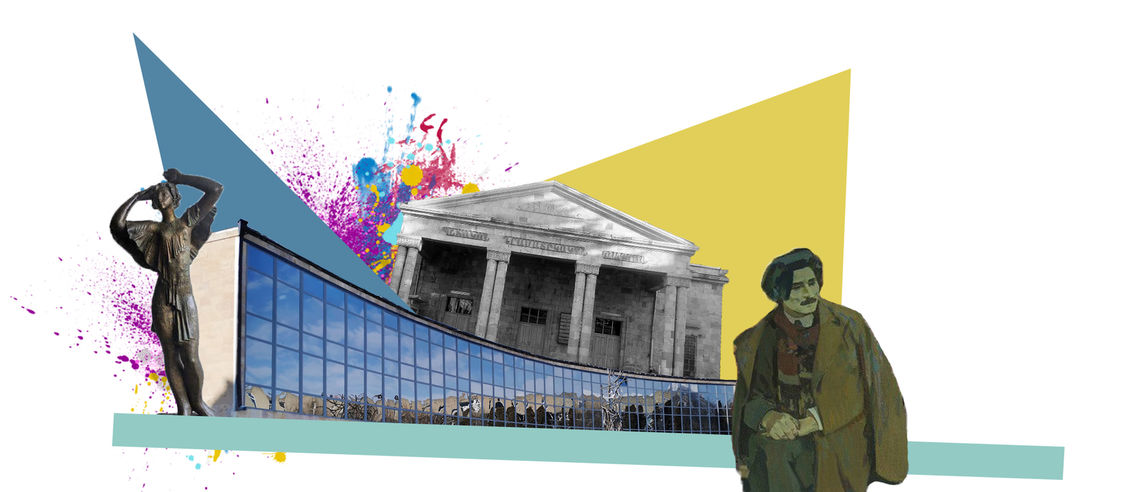
Walking around Vanadzor, the capital of Lori region, one can’t help but notice the drab, gray colors. The factories of Kirovakan, as the city was named during the Soviet years, gave it the reputation of an industrial powerhouse. Though the unfading scent of textiles still betrays the city’s past, those factories have long since stood idle, and the jobs they provided survive only in conversations. It is most probably the former reputation of the Kirovakan of old that confuses visitors who find themselves at 5 Taterakan Street and ask a "naive” question: “Do you even have a theater?”
Vanadzor’s Hovhannes Abelyan Theater, built by architect Hrachik Amirbekyan in the early 20th century, is just a few meters away from the Vanadzor Museum of Fine Arts, built under the leadership of Leon Khachatryan. Both buildings contain the memories and feelings of this city.
***
A heated discussion is taking place on the grounds of the Hovhannes Abelyan Theater. Even under a state of emergency caused by the pandemic, the theater does not want to take a rest. Only after clarifying the final details does Vahe Shahverdyan, the theater's art director, step up to his office on the second floor. The parquet is squeaking; the art director hurries to dispel everyone’s anxiety: “The theater is under renovation now and this creaking will be fixed and the floor will be replaced. The seats of the theater hall, the stage lighting, everything will be replaced soon. Unofficial sources say that the reconstruction may last up to four years.”
The unusual silence in the hallway is sometimes interrupted by the voices of actors rehearsing in one of the offices. “It is very difficult for the artists,” Shahverdyan continues. “The artist cannot be without the stage and the audience, so while we must abide by the COVID-19 provisions, we must look for solutions. This is also a unique opportunity to understand the extent of one’s creativity, and we are slowly finding ways to stay engaged with the audience and fill the gap in communication.”
Before the theater was founded, when the city was named Gharakilise, professional actors used to form amateur troupes and travel from town to town across Armenia. One specific actor not only participated in the performances, but also tried to help as much as he could. When the theater was founded in 1931, it was named in honor of that actor, Hovhannes Abelyan.
Shahverdyan was 11 years old when he first came on stage at this theater. While his debut was challenging, he fell in love with the theater and began spending hours backstage. During his childhood, famous actors like Vahram Papazyan, Hrachya Nersisyan, Arus Voskanyan and others brilliantly acted on the stage.
Once, before a performance portraying Othello, Vahram Papazyan asked Shahverdyan, who was still a child at the time, to go to actress Aghavni Hovhannisyan's home and fetch him coffee. “I went to Mrs. Aghavni's house and said that Papazyan wanted some coffee. For the first time in my life, I saw this so-called ‘jezvé,’” Shahverdyan recounts. “The lady handed me a very small cup, the jezvé and asked me to deliver it carefully. This was one of the most memorable episodes of my life. The next day, I, an eleven-year-old child, was shouting all over the house to give me some of Papazyan's coffee. My poor mother and grandmother were bewildered; they did not understand what a jezvé was, and what kind of coffee was in it.”
The theater, that has toured the world and hosted world-renowned actors, has no shortage of young talent. There are also actors who have been working here for fifty years. Vahe Shahverdyan is very meticulous when it comes to choosing an actor: “You see, one of the main traditions of this theater is to value and develop qualities and talent, so I am responsible for this hearth. I cannot choose an actor without approaching the matter seriously, because they are an essential part of this cultural organism.”
During the pandemic, the theater has been staging open-air performances and providing the audience with a large number of recorded performances from their archives. Two special performances are also being prepared for television broadcast, but even when the epidemic ends, the theater will be closed for some time due to the renovations.
Shahverdyan says they had been looking at a number of alternative venues to hold their performances but kept coming up short. “We were looking for a more chamber-style environment,” he says and adds that they were considering a small hall in the house-museum of writer Stepan Zoryan which could accommodate about fifty people when they noticed the garden. “We realized that we had found what we had been looking for. It was there that the idea to perform the writer’s ‘Apple Orchard’ in his own garden was born.”
Naturally, this performance of Zoryan’s piece, without a stage or set decorations will not be "ordinary" but it will have one other important and distinctive element. “It will be accompanied by a live music performed by musicians,” Shahverdyan says. “We have a friend, a composer living in Vanadzor, Vardan, who came, listened to the rehearsal and said that he would compose the score for the ‘special’ performance.”
Vahe Shahverdyan has witnessed both the heyday and decline of this theater. Since the founding of the theater, when the first play "Exasperation" was staged, it was always sold-out. He remembers how in the 1980s, the theater was thriving and even the 1988 earthquake was not able to break the spirit of the artists. After two weeks of confusion, the theater rose to its feet, convinced that people needed art more than ever during that period. In the 1980s, the fame of this cultural institution resounded throughout the USSR.
“I may sound immodest, but at that time it was the leading theater in Armenia. We performed our famous play ‘Three Sisters’ in different countries, including France, Lithuania, Portugal and Latvia,” Shahverdyan says. On the wall of his office, there is a poster printed in France, where there are three men instead of three sisters. “It was a bad joke,” he says, recalling how he looked at the three men in amazement when he saw the poster for the first time, but it had already appeared in the pages of Parisian newspapers.
During the Soviet years, the government, with a vision of developing an educated society, gave everyone the opportunity to go to the theater by providing them with subscriptions - both the worker and the scientist, the teacher and the doctor. Shahverdyan says that cultural institutions were always overflowing with people. Even in the dark and cold years of the 1990s, when the roof was leaking, and there was no heating, the Hovhannes Abelyan Theater did not give up. There was an insatiable desire to fill the darkness and cold with art.
Parajanov’s Gift
“Many years ago, I performed ‘The Floor Trembles’ by Mikhail Buznik,” Shahverdyan recalls. “During one of the rehearsals, I was told that Buznik was in Kirovakan and wanted to be present at the rehearsal. Afterward he said he would like to invite his friend Sergey Parajanov to the premiere of the play. Without hesitation, I said ‘Of course! No problem!’”
Shahverdyan admits that the play was very bold and, at that time with Soviet censorship, they could even be imprisoned for such performances. However, after the premiere, Parajanov came up on stage and gave a laconic speech:
“Before the performance, I went to the house of actress Veriko Anjaparidze [a famous Georgian actress] and said that my Armenian friends have called me back to watch a play, so give me something to take as a souvenir. She gave me a marvelous pitcher, which I left in the car because I thought that if the performance was bad, I would not present it as a gift.”
The following day, the City Committee and the Central Committee of the Communist Party discussed the issue of dismissing Shahverdyan from the theater. This is when his nightmare began: Why had he invited Parajanov, a persona non grata, to the performance? As the people of Lori say, “the case went to trial.” The art director of the theater eventually found himself in the office of Karen Demirchyan, the First Secretary of the Central Committee of the Communist Party of Armenia. The meeting was short and meaningful: “Karen Serobich said, ‘Keep this to yourself, but you did well.’”
The pitcher presented by Parajanov is still kept with great care in Vahe Shahverdyan's house.
A City of Fine Arts
In the June 11, 1974 issue of Kayts [“lightening” in Armenian] an article appeared headlined “A Great Festival of Art” that said: "On Saturday, June 8, art lovers and workers of our city received an invaluable, wonderful gift. The Kirovakan city gallery was opened… In one day, more than 3000 art lovers visited the museum.”
It is only a few steps from 5 Taterakan Street to 52 Tigran Mets Street. Those who visit Vanadzor for the first time immediately notice the similarities between the buildings of the famous "Univermag" department store and the Museum of Fine Arts. In 1974, this building was built as a supplement to the department store and served as a consumer service center. It was later refurbished to become a branch of the State Gallery of Armenia. Five years later, it became an independent Fine Arts Museum named after Armenian painter Karlos Abovyan.
There are many trees on the grounds of the Fine Arts Museum, but one of them stands out: the "Friendship Tree." The work of sculptor Albert Ferro, it is dedicated to the friendship between the cities of Vanadzor and Bagneux, France. It has a symbolic significance. The locals cannot imagine the grounds of the museum without this tree. Like the theater, the museum is being renovated, scheduled to be completed soon. The former director of the museum, currently a researcher, painter Papag Aloyan, was the director of the museum for 18 years. He jokingly says that his studio was upset with him, accusing him of spending time as an administrator instead of painting. “I decided that was the truth and decided to stay on at the Museum, but only as a researcher,” he says.
The Acting Director of the Vanadzor Museum of Fine Arts, young philologist Haykuhi Avagyan, has worked in the museum for many years. She can tell you which artwork is placed on which part of the wall with her eyes closed. “The building is rather big,” Avagyan says. “You will find thematic halls on each of the three floors. It looks like there are mini museums on every floor. We have 1800 items in the gallery, 250 of which are on display.”
The sculpture and graphics section is on the first floor, where a whole wall is dedicated to the portraits of contemporary Armenian artists. Almost 90% of the permanent exhibition of the museum remains unchanged. There are artworks in the archive that are gifts, but they have never been exhibited and probably will never be shown to visitors. Papag Aloyan says that not every artwork can be displayed as a work of art. “We gladly accept gifts, but if the level of the artwork does not meet our standards, we cannot show it,” he explains.
The artist remembers that when he had just been demobilized from the army and learned that a museum of fine art had opened in Kirovakan, he brought one of his works to show to the museum administration. “I was a fresh graduate and I did not have any expectations that my work would be selected for the upcoming exhibition,” Aloyan says. “But it was shown not only in Kirovakan, but also in Yerevan and reached the United States, where it was sold. I, a naive and young artist, was satisfied only with the joy that it had crossed the ocean. I did not know who bought it, how much they paid, that’s how the times were.”
Haykuhi Avagyan says that there is no shortage of young artists’ works in the gallery. It is a unique synthesis of old and new generations and a sharp eye will immediately notice the differences in style, expression and technique.“The mentality of the generations is certainly noticeable in the artists’ handwriting,” she explains. “I am convinced that the overwhelming majority of the works in our gallery represent the Saryan school, the same color perceptions, the same accents. The style of the younger generation is closer to modern art than ever before, so I'm sure the difference is obvious. That’s what makes the museum inclusive, because all generations have something to say.”
Tickets here can confuse residents of Yerevan and tourists, as the price is ridiculously low compared to the tickets of cultural centers in the capital. But both Avagyan and Aloyan note that while developing the price policy, average income is taken into account. Art should be available to everyone they insist.
“There were days when we had one or two visitors, and there were days when we had so many visitors, we did not know what to do," says Avagyan. “Especially since we joined the event called Museum Night, we have hosted a large number of art lovers. The pandemic is hindering our work. If the theater is able to find solutions, then the museum suffers, as it deals with artworks. For example, we cannot display these works in the yard, because they can be damaged by weather conditions.”
The musem has implemented a number of projects, one of which is a four-language audio work about the museum’s artifacts. Recording has already been completed, and soon guests and tourists visiting Vanadzor can hear the pulse of the gallery with the help of headphones. The acting director of the museum says that this is a step towards communicating with art lovers.
“This will allow people with visual impairments to come and get acquainted with the exhibits through a so-called Tiflo translation,” Avagyan explains. “There are many new projects, and the renovation will be completed soon, and we will be able to fully present ourselves to the public.”
They are not very satisfied, however, with the renovation underway. Avagyan says it would have been good if they had been consulted about some of the details. “I would completely change the way the lights are installed because depending on the lighting and the particular angle of light, the artwork can be elevated or you do a disservice to it,” she explains. “But the reconstruction is being carried out by state funds and they are trying to do what they can with the funds that have been allocated.”
The Fine Arts Museum has not welcomed visitors for a long time. The only visitor to the museum is Grandpa Serzh, who has worked as a security guard here for decades. "This is my house, I cannot do without these walls," he says, leaning on a chair and enjoying his coffee, as he would in his own house.
People whisper as they pass the Fine Art Museum. Тhey wonder when it will open its doors. But behind the apparent silence, there are new plans, commitment and will to change the city’s image. Haykuhi Avagyan says she has received various offers to work in Yerevan but has declined: “This is my city; I am responsible for making it better.”
***
Reconstruction is underway in the regional center of Lori. The city is buzzing with vibrancy preparing for a new day. Who knows? Maybe the time will come when Vanadzor of the 21st century will leave the glory days of Kirovakan of the 20th century in its shadow.
also read
Heritage and the Contemporary
By Movses Hrayr Der Kevorkian
When emphasizing the preservation of historic structures and their integration into unban life, we should keep in mind that heritage should not be perceived as only architectural heritage and we should not think that it is only the physical heritage that is endangered.
Mariam and Eranuhi Aslamazyan: Beloved Artists of the Soviet Union
By Arpine Haroyan
Mariam and Eranuhi Aslamazyan are two of the most well-known female painters of Soviet Armenia. They broke stereotypes in the art world and left behind a rich legacy and heritage.
Musical Dilijan: The Cultural Hub of Soviet Armenia
By Arpine Haroyan
The resort town of Dilijan in Armenia is known for its lush mountainous landscapes. It is also home to the Composers’ Union Resort, a place that hosted world famous composers in the 1960s and became a cultural hub in the former Soviet Union.
Art and Social Change: Mughdusyan’s Mission of Emancipating Women and Empowering Youth
By Gayane Ghazaryan
Mariam Mughdusyan had a dream and a goal - to bring about social change through the power of art and music and give children what she was once deprived of and help them to overcome poverty.
From Censorship to State Sponsorship: The Fate of Jazz in the Soviet Union and Armenia
By Gayane Ghazaryan
Jazz and Armenia have a complicated history. From its early beginnings under Soviet rule to contemporary interpretations of jazz, the genre is part of the fabric of Armenian cultural life.
Meghradzor: How Old Tales From the Villages are Being Preserved by the Community
By Joe Nerssessian
An artistic collaboration spanning continents and generations is attempting to turn stories into colorful murals throughout rural communities in Armenia.
Finding Beauty in a Decaying Theater
By Joe Nerssessian , Tsovinar Hakobyan
Despite its obvious ruin, Stepanakert’s grand dramatic theater captures the beauty of a past era and now there are efforts to restore the structure’s life and soul in the same spirit of how it was built.
The Sculptor of Death Masks
By Kristen Anais Bayrakdarian
Born in Gyumri in the late 19th century, Sergey Merkurov is considered the greatest Soviet master of death masks. He was highly sought after to take the death masks of various Soviet luminaries and leaders, as well as prominent cultural figures of the era.
Back to the USSR: Vintage Soviet Glassware
By Arpine Haroyan
An extensive collection of vintage Soviet glassware has found a home in Gyumri, Armenia’s second largest city. Boasting over 1600 pieces, the collection was carefully curated by collector Artush Mkrtchyan. Arpine Haroyan unfolds the history of the collection to its post-WWII origins.


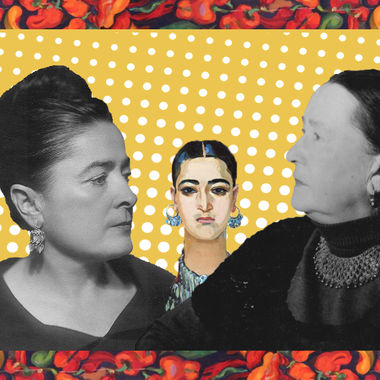
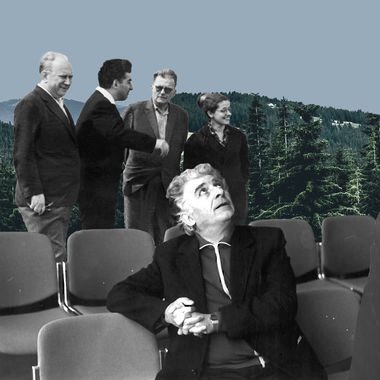

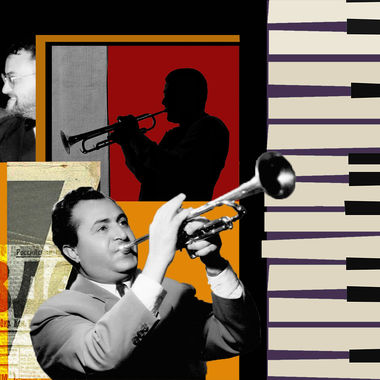

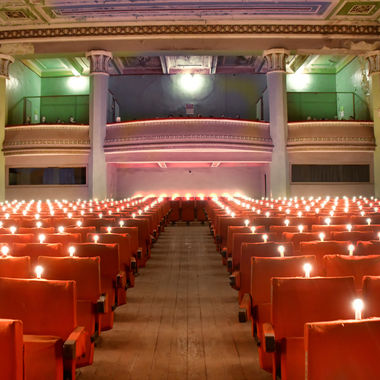
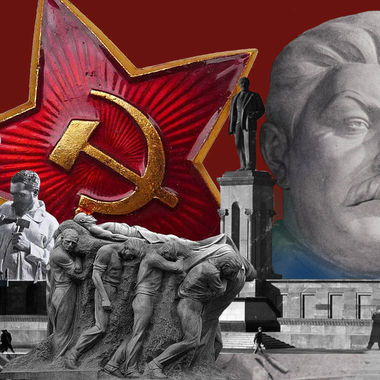



EVN Report welcomes comments that contribute to a healthy discussion and spur an informed debate. All comments will be moderated, thereby any post that includes hate speech, profanity or personal attacks will not be published.